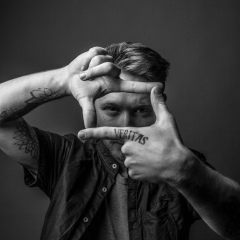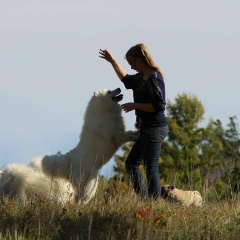И въ воздухѣ, жидкомъ отъ душевныхъ поллюцiй,
Отъ фанфаръ «Варшавянки», сотрясающихъ балконъ,
Кто-то самый умный назвалъ революцiю
Менструацiей этихъ кровавыхъ знамёнъ.
Знаю-знаю, женщины терпѣть не могутъ шутки про регулы, а потому сразу прошу прощенiя у всѣхъ сестёръ во Антихристѣ за Вадима Шершеневича.
Новая икона, только что вышедшая изъ-подъ колонковыхъ кистей схiархидекадента Антонiя, относится къ условному типу иконъ «историческихъ». Подъ «историческими» я понимаю иконы, изображающiя событiя реальной, а не библейской исторiи или агiографическiе сюжеты. Къ наиболѣе характернымъ примѣрамъ можно отнести иконы «Торжество православiя» или, скажемъ, знаменитѣйшую «Битву новгородцевъ съ суздальцами». Есть и современные примѣры: «Новорусская икона Богоматери» Сергея Куракина, посвящённая исторiи строительства, уничтоженiя и возсозданiя Храма Христа Спасителя (та ещё кликушеская дичь, хотя кто бы говорилъ…).
Короче, какъ вы уже догадались, нашъ очередной шедевръ называется «Торжество Революцiи» и раскрываетъ сатанинскую точку зрѣнiя на событiя Русской революцiи и Гражданской войны.
Что же мы видимъ на левкасѣ?
Взорванный храмъ, уходя подъ землю, утопаетъ въ сизой пыли, Христосъ попранъ двѣнадцатью (привѣтъ, Александръ Александровичъ!) красноармейцами — апостолами антихристовыми — и являетъ собою какъ бы мостъ: отъ разрушенiя церкви, черезъ «убiйство» Христа, нѣкогда народъ-богоносецъ устремляется по поруганному Тѣлу Спасителя въ адъ, въ отверстую пасть Звѣря. Богатѣйшая русская земля межъ тѣмъ разорена и пребываетъ въ «мерзости запустѣнiя» (Мф. 24:15), рождая лишь «тернiя и волчцы» (Быт. 3:18). Бѣсъ сзади подталкиваетъ копьёмъ идущихъ, бѣсъ спереди крюкомъ пытается утянуть ихъ въ преисподнюю, и вотъ уже нога на краю обрыва… а надо всѣмъ этимъ ужасомъ ангелы Сатаны несутъ красное знамя, кровавою пеленою заволакивающее Русь.
Вотъ ещё неожиданный символизмъ: красный флагъ противопоставленъ бѣлой набедренной повязкѣ Христа, а будёновки красноармейцевъ напоминаютъ вздыбленные волосы — непремѣнную особенность бѣсовъ и грѣшниковъ въ православной иконографiи. Штыки же какъ чёрныя молнiи, бьющiя съ земли въ небо, торжествующiя побѣду Человѣкобога надъ Богочеловѣкомъ! (Прямъ стихами заговорилъ, ёптить!)
Въ своей работѣ я въ основномъ обращался къ иконамъ: «Соборъ новомучениковъ и исповѣдниковъ россiйскихъ» — отсюда красноармейцы; упоминавшаяся выше «Новорусская Богоматерь» Куракина — рушащiйся храмъ и многочисленныя надписанiя, нездоровая страсть автора къ которымъ передалась и мнѣ: дурной примѣръ заразителенъ; «Положенiе во гробъ» — Тѣло Христово; «Покровъ Пресвятой Богородицы» — кумачъ.
Кстати, про покровъ: у нѣкоторыхъ явленiй церковной жизни есть, наряду съ офицiальнымъ, и народное наименованiе. Ярчайшiй случай — Спасъ на Крови, который вообще-то Соборъ Воскресенiя Христова. Такъ вотъ, когда мои адепты заполонятъ страну и государственной религiей Россiи станетъ мой изводъ сатанизма, икона «Торжество Революцiи» получитъ въ народѣ названiе «Покровъ сатанинъ» и предъ нею вѣрующiя будутъ молить силы зла о покровительствѣ и защитѣ отъ… зла! Да, какъ ни крути, а сатанизмъ крайне противорѣчивая штука.
Откровенно говоря, по объективнымъ причинамъ никакъ не могу считать совѣтскую власть дiавольскою, но ужъ покуда она отвергала Бога и церковь (а я скорѣе сатанистъ, нежели коммунистъ), вынужденъ признать церковную точку зрѣнiя на происхожденiе большевиковъ, и, слѣдовательно, вписать Русскую революцiю въ мистическую исторiю человѣчества какъ прямой сатанинскiй актъ. Такъ что, Революцiя, здравствуй!
P.S. И напослѣдокъ, во имя всеобщаго примиренiя, позвольте мнѣ ещё одну пафосную цитату:
Всѣхъ убiенныхъ помяни, Россiя,
Егда прiидеши во царствiе Твое!
#сатанизм #икона #революция #большевизм #адопись #satanism #icon #revolution #bolshevism #orthodox
Отъ фанфаръ «Варшавянки», сотрясающихъ балконъ,
Кто-то самый умный назвалъ революцiю
Менструацiей этихъ кровавыхъ знамёнъ.
Знаю-знаю, женщины терпѣть не могутъ шутки про регулы, а потому сразу прошу прощенiя у всѣхъ сестёръ во Антихристѣ за Вадима Шершеневича.
Новая икона, только что вышедшая изъ-подъ колонковыхъ кистей схiархидекадента Антонiя, относится къ условному типу иконъ «историческихъ». Подъ «историческими» я понимаю иконы, изображающiя событiя реальной, а не библейской исторiи или агiографическiе сюжеты. Къ наиболѣе характернымъ примѣрамъ можно отнести иконы «Торжество православiя» или, скажемъ, знаменитѣйшую «Битву новгородцевъ съ суздальцами». Есть и современные примѣры: «Новорусская икона Богоматери» Сергея Куракина, посвящённая исторiи строительства, уничтоженiя и возсозданiя Храма Христа Спасителя (та ещё кликушеская дичь, хотя кто бы говорилъ…).
Короче, какъ вы уже догадались, нашъ очередной шедевръ называется «Торжество Революцiи» и раскрываетъ сатанинскую точку зрѣнiя на событiя Русской революцiи и Гражданской войны.
Что же мы видимъ на левкасѣ?
Взорванный храмъ, уходя подъ землю, утопаетъ въ сизой пыли, Христосъ попранъ двѣнадцатью (привѣтъ, Александръ Александровичъ!) красноармейцами — апостолами антихристовыми — и являетъ собою какъ бы мостъ: отъ разрушенiя церкви, черезъ «убiйство» Христа, нѣкогда народъ-богоносецъ устремляется по поруганному Тѣлу Спасителя въ адъ, въ отверстую пасть Звѣря. Богатѣйшая русская земля межъ тѣмъ разорена и пребываетъ въ «мерзости запустѣнiя» (Мф. 24:15), рождая лишь «тернiя и волчцы» (Быт. 3:18). Бѣсъ сзади подталкиваетъ копьёмъ идущихъ, бѣсъ спереди крюкомъ пытается утянуть ихъ въ преисподнюю, и вотъ уже нога на краю обрыва… а надо всѣмъ этимъ ужасомъ ангелы Сатаны несутъ красное знамя, кровавою пеленою заволакивающее Русь.
Вотъ ещё неожиданный символизмъ: красный флагъ противопоставленъ бѣлой набедренной повязкѣ Христа, а будёновки красноармейцевъ напоминаютъ вздыбленные волосы — непремѣнную особенность бѣсовъ и грѣшниковъ въ православной иконографiи. Штыки же какъ чёрныя молнiи, бьющiя съ земли въ небо, торжествующiя побѣду Человѣкобога надъ Богочеловѣкомъ! (Прямъ стихами заговорилъ, ёптить!)
Въ своей работѣ я въ основномъ обращался къ иконамъ: «Соборъ новомучениковъ и исповѣдниковъ россiйскихъ» — отсюда красноармейцы; упоминавшаяся выше «Новорусская Богоматерь» Куракина — рушащiйся храмъ и многочисленныя надписанiя, нездоровая страсть автора къ которымъ передалась и мнѣ: дурной примѣръ заразителенъ; «Положенiе во гробъ» — Тѣло Христово; «Покровъ Пресвятой Богородицы» — кумачъ.
Кстати, про покровъ: у нѣкоторыхъ явленiй церковной жизни есть, наряду съ офицiальнымъ, и народное наименованiе. Ярчайшiй случай — Спасъ на Крови, который вообще-то Соборъ Воскресенiя Христова. Такъ вотъ, когда мои адепты заполонятъ страну и государственной религiей Россiи станетъ мой изводъ сатанизма, икона «Торжество Революцiи» получитъ въ народѣ названiе «Покровъ сатанинъ» и предъ нею вѣрующiя будутъ молить силы зла о покровительствѣ и защитѣ отъ… зла! Да, какъ ни крути, а сатанизмъ крайне противорѣчивая штука.
Откровенно говоря, по объективнымъ причинамъ никакъ не могу считать совѣтскую власть дiавольскою, но ужъ покуда она отвергала Бога и церковь (а я скорѣе сатанистъ, нежели коммунистъ), вынужденъ признать церковную точку зрѣнiя на происхожденiе большевиковъ, и, слѣдовательно, вписать Русскую революцiю въ мистическую исторiю человѣчества какъ прямой сатанинскiй актъ. Такъ что, Революцiя, здравствуй!
P.S. И напослѣдокъ, во имя всеобщаго примиренiя, позвольте мнѣ ещё одну пафосную цитату:
Всѣхъ убiенныхъ помяни, Россiя,
Егда прiидеши во царствiе Твое!
#сатанизм #икона #революция #большевизм #адопись #satanism #icon #revolution #bolshevism #orthodox
And in the airѣ, liquid from the soul’s half-hearted,
From the fanfare of the Varshavyanka that shakes the balcony,
Someone the smartest called the revolution
Menstruation of these bloody banners.
I know, I know, women can’t tolerate jokes about regulation, and therefore I immediately apologize to all the sisters in the Antichrist for Vadim Shershenevich.
The new icon, which has just come out of the column brushes of the Archdecade Antony, belongs to the conditional type of icons of the “historical”. By “historical” I understand icons depicting events of real, not biblical, history or agiographic plots. The most characteristic example is the icon “The Triumph of Orthodoxy” or, say, the famous “Battle of Novgorod against Suzdal”. There are also modern examples: the “New Russian Icon of the Mother of God” by Sergei Kurakin, dedicated to the history of construction, destruction and rebuilding of the Cathedral of Christ the Savior (that is still clicher game, although who would say ...).
In short, as you may have already guessed, our next masterpiece is called "The Triumph of the Revolution" and reveals the satanic point of view at the events of the Russian Revolution and the Civil War.
What do we see in gesso?
The blown up temple, going underground, drowns in dust, Christ violated the twelve (privet, Aleksandr Aleksandrovich!) Red Army soldiers - the apostles of the Antichrist - and is like a bridge: the destruction of the church, through the “destruction” of Christ, is not long before abused Tulu of the Savior in hell, in the opening mouth of the Beast. The richest Russian land was devastated between the two and is in the “abomination of desolation” (Matthew 24:15), giving birth only to “thorns and thistles” (Genesis 3:18). The rear spear is pushing those walking, the front hook is trying to pull them into the underworld, and now there is already a foot on the edge of the cliff ... but with all this horror, the angels of Satan are carrying a red banner, covering Russia in bloody shroud.
Here is another unexpected symbolism: the red flag is contrasted with the white loincloth of Christ, and the Budenovka Red Army men resemble reared hair - an indispensable feature of the bosov and the sinners in Orthodox iconography. The bayonets are like black lightning, beating from the earth into the sky, triumphing over the Human God over the God-men! (Straight up in verse, speak up!)
In my work, I mainly turned to the icons: “The Cathedral of the New Martyr and Confessor of the Russians” - hence the Red Army; the “New Russian Mother of God” mentioned above by Kurakina - a crumbling temple and numerous inscriptions, the author’s unhealthy passion for which was transmitted and many: a bad example is contagious; “Lay in the sepulcher" - The Body of Christ; "Protection of the Most Holy Theotokos" - Kumach.
By the way, about the veil: some of the phenomena of church life have, along with official, a national name. The most striking case is the Savior on Blood, which is actually the Cathedral of the Resurrection of Christ. So then, when my adherents will occupy the country and the state religion of Russia will become my harassment of Satanism, the icon "The Triumph of the Revolution" will be called the people "Cover the Satan" and presenting it to believers will pray evil forces for protection and protection from ... Yes, whatever one may say, Satanism is an extremely controversial thing.
Frankly, for objective reasons, I just can’t consider Soviet power to be devilish, but as long as it rejected God and the church (and I rather Satanist than the communist), I have to admit the church point of view on the origin of the Bolsheviks, and, therefore, enter the Russian Revolution the history of humanity as a direct satanic act. So that, Revolution, hello!
P.S. And finally, in the name of universal reconciliation, let me give you one more pathos quote:
Remember all the dead, Russia,
Everywhere in thy kingdom!
#Satanism #icon # revolution # Bolshevism #address #satanism #icon #revolution #bolshevism #orthodox
From the fanfare of the Varshavyanka that shakes the balcony,
Someone the smartest called the revolution
Menstruation of these bloody banners.
I know, I know, women can’t tolerate jokes about regulation, and therefore I immediately apologize to all the sisters in the Antichrist for Vadim Shershenevich.
The new icon, which has just come out of the column brushes of the Archdecade Antony, belongs to the conditional type of icons of the “historical”. By “historical” I understand icons depicting events of real, not biblical, history or agiographic plots. The most characteristic example is the icon “The Triumph of Orthodoxy” or, say, the famous “Battle of Novgorod against Suzdal”. There are also modern examples: the “New Russian Icon of the Mother of God” by Sergei Kurakin, dedicated to the history of construction, destruction and rebuilding of the Cathedral of Christ the Savior (that is still clicher game, although who would say ...).
In short, as you may have already guessed, our next masterpiece is called "The Triumph of the Revolution" and reveals the satanic point of view at the events of the Russian Revolution and the Civil War.
What do we see in gesso?
The blown up temple, going underground, drowns in dust, Christ violated the twelve (privet, Aleksandr Aleksandrovich!) Red Army soldiers - the apostles of the Antichrist - and is like a bridge: the destruction of the church, through the “destruction” of Christ, is not long before abused Tulu of the Savior in hell, in the opening mouth of the Beast. The richest Russian land was devastated between the two and is in the “abomination of desolation” (Matthew 24:15), giving birth only to “thorns and thistles” (Genesis 3:18). The rear spear is pushing those walking, the front hook is trying to pull them into the underworld, and now there is already a foot on the edge of the cliff ... but with all this horror, the angels of Satan are carrying a red banner, covering Russia in bloody shroud.
Here is another unexpected symbolism: the red flag is contrasted with the white loincloth of Christ, and the Budenovka Red Army men resemble reared hair - an indispensable feature of the bosov and the sinners in Orthodox iconography. The bayonets are like black lightning, beating from the earth into the sky, triumphing over the Human God over the God-men! (Straight up in verse, speak up!)
In my work, I mainly turned to the icons: “The Cathedral of the New Martyr and Confessor of the Russians” - hence the Red Army; the “New Russian Mother of God” mentioned above by Kurakina - a crumbling temple and numerous inscriptions, the author’s unhealthy passion for which was transmitted and many: a bad example is contagious; “Lay in the sepulcher" - The Body of Christ; "Protection of the Most Holy Theotokos" - Kumach.
By the way, about the veil: some of the phenomena of church life have, along with official, a national name. The most striking case is the Savior on Blood, which is actually the Cathedral of the Resurrection of Christ. So then, when my adherents will occupy the country and the state religion of Russia will become my harassment of Satanism, the icon "The Triumph of the Revolution" will be called the people "Cover the Satan" and presenting it to believers will pray evil forces for protection and protection from ... Yes, whatever one may say, Satanism is an extremely controversial thing.
Frankly, for objective reasons, I just can’t consider Soviet power to be devilish, but as long as it rejected God and the church (and I rather Satanist than the communist), I have to admit the church point of view on the origin of the Bolsheviks, and, therefore, enter the Russian Revolution the history of humanity as a direct satanic act. So that, Revolution, hello!
P.S. And finally, in the name of universal reconciliation, let me give you one more pathos quote:
Remember all the dead, Russia,
Everywhere in thy kingdom!
#Satanism #icon # revolution # Bolshevism #address #satanism #icon #revolution #bolshevism #orthodox

У записи 5 лайков,
0 репостов,
136 просмотров.
0 репостов,
136 просмотров.
Эту запись оставил(а) на своей стене Антон Воронцов

























